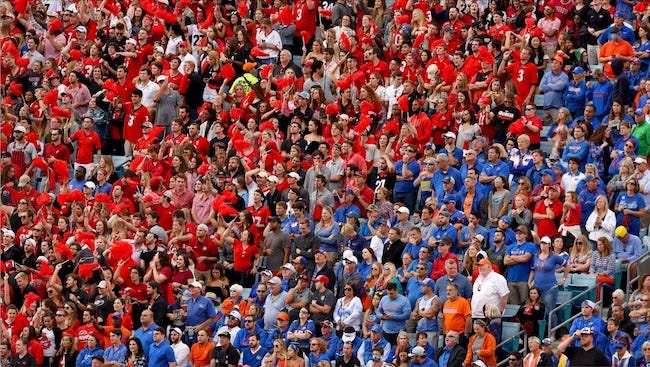America's Ideological Blindspot
So caught up in the blue v. red rivalry, loyal fans defend even their shittiest players while scorning the objectively good ones from the opposing side. What if we're looking at it wrong?
Americans love our sports. And, we’re obsessed with politics. So, it’s no surprise that the whole political red team vs. blue team thing has become the greatest sports rivalry of all—complete with relentless analysis, zealous fans, and talking heads on screens 24/7.
Political tribalism leaves scant room for anything less than devout loyalty to a side—let alone thoughtful nuance or curiosity about areas of mutual agreement that are in the interest of the common good.
America’s tribal blindspot
Our blindspot is that as loyal fans, we’ve lost objectivity on the worthiness of the individual players on our team, let alone theirs—to a red, all blues appear unhinged, and to a blue, all reds look nuts.
Herein lies the fallacy
The truth is, neither side has a monopoly on crazy, while both sides harbor thoughtful and reasonable folks. The big problem, though, is partisans are unable to see toxicity within their own team and instead ascribe it only to the other.
Non-partisans and independents who are not blinded by team loyalties can see it though. So much so that those who identify as independent have largely disengaged from civics. Fed up, they’ve ceded electoral power to motivated voters who trend to the ideological extremes.
And, here we are.
But, what if we are looking at it wrong?
Staying with the sports metaphor, instead of the false choice between fielding players from the red or blue teams, what if we could assemble a team of all-stars—electing only the most rational, pragmatic, and collaborative representatives from either party who span the full range of ideological leanings?
In collaborative governance (win-win game), ideological differences by individuals means a lot less than in today’s winner take all politics (zero-sum game).
How do we identify these political all-stars?
This is what Bridge Grades is for.
To identify all-stars in sports, we use objective data and look at their stats. Batting average. Shooting percentage. Yards per carry.
With Bridge Grades we do the same. We use objective data based on observable behaviors (like legislative record and political rhetoric) as their player statistics. We use this data to rank, grade, and sort bridgers from dividers. Bridgers build coalitions, collaborate across parties, and legislate solutions for our common interests. Dividers vote with unflinching partisan records and more regularly engage in personal attacks.
Specifically, Bridge Grades offer high marks to politicians who co-author and co-sponsor bills written by members of the opposite party. Why is this so important? When bridgers who are ideological opposites write legislation together, it forces them to listen to each other’s views and craft mutually beneficial solutions by finding overlapping interests (win-win). In contrast, dividers who refuse to engage in collaborative efforts ensure that corresponding legislative interests are one-sided to the detriment of the others (zero-sum).
Does it work?
Decide for yourself. Our Bridge Grades for Congress (2024) from last congressional term show a distribution of grades (A, B, C, F) across the full spectrum of ideology. It identifies all-stars (grade As) from both parties who span a wide range of personal ideologies.
How to read this chart
The left-to-right horizontal axis plots ideology ratings (from VoteView) with most progressive to the far left and most conservative to the far right.
The up-and-down vertical axis (Bridge Scores) plot the most collaborative members of Congress at the top (purple Grade As) and the divisive ones at the bottom (grey Grade Fs).
Two screaming takeaways from the chart
To no one’s surprise, the ideological middle is massively underrepresented. Seeing the visualized data is striking.
You don’t have to be a centrist to earn an A.
Let’s linger on this second point. As written about previously, America is strong because we permit a wide range of ideological beliefs, not despite of it. We’ve been tricked into believing that our differences are to blame when it’s really that we are too busy fighting about them rather than finding win-win solutions for our common interests.
Bridger politicians do just this. While maintaining personal ideological beliefs, they, more often than their peers, collaborate with those from other ideologies to co-govern our deliciously eclectic population.
Our thesis is that if we can rally as citizen voters and systematically re-elect bridgers and vote out dividers, the political incentive to govern more collaboratively can change the culture of politics and maybe even a nation.
The way out of the red vs blue trap
Step 1 is for partisan sports fans to drop the pom-poms and wipe off the face paint.
Step 2 is to get curious about political all-stars and get in the habit of supporting As and Bs instead of reds or blues.
If this makes sense to you, I hope you check out last term’s Bridge Grades, sign up here for updates, and share these with other like minded citizens you know who are open to another way forward.
Bridge Grades is a non-ideological report card for politicians. Using 3rd party data, we grade politicians on their abilities to collaborate and build consensus solutions for the common interests of multiple parties versus how polarizing they behave. In aggregating data from multiple non-partisan 3rd party sources, Bridge Grade is like Rotten Tomatoes for politicians. Bridge Grades measure not “what” a politician thinks, but rather “how” the politician behaves. Independent of red or blue, Bridge Grades sorts bridgers from dividers.





